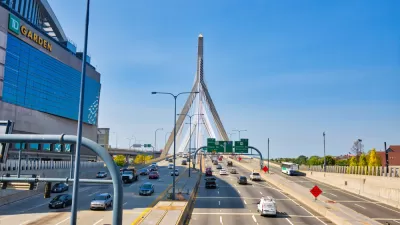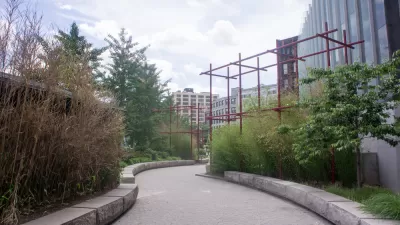Ten years after the completion of the Central Artery and Tunnel project—or the Big Dig, as it's more commonly known—has the project become more justifiable?
Anthony Flint takes a look back at the Big Dig—that infamous, long-delayed, well-over-budget project that created the most expensive highway in U.S. history.
After Flint spends a few paragraphs writing in a style close to prose poetry to describe the development process for the Central Artery and Tunnel project, we arrive to the present day—ten years after the official completion of the project. "How are we feeling now?" Flint asks. "Maybe there’s room for some grudging appreciation."
The feature length article provides background on the political and planning processes that lead up to the project before focusing on the outcomes of the project. On that latter point, Flint reports a mixed bag regarding the congestion relief pitched as a primary benefit of the project: "Looking at the new roadway system by itself, the Central Artery and Tunnel project is solving that problem [of congestion], with capacity to spare." Yet also, "[t]he theory of induced demand…has played out as predicted, particularly at the Ted Williams Tunnel, where traffic typically stacks up every evening trying to get to East Boston, Logan, and points north."
Flint also uses the perspective offered by the passage of town to analyze some of the design and execution of the project. One line sums up the analyses well: "for every triumph, there were gaffes." The article also includes evaluations about the potential transit investments that could have been funded with some of the project's $15 billion price tag as well as some of the project's benefits to the city's landscape, urban design, and development market. Flint concludes by considering whether the project could have been conceived and completed any other way.
FULL STORY: 10 years later, did the Big Dig deliver?

Study: Maui’s Plan to Convert Vacation Rentals to Long-Term Housing Could Cause Nearly $1 Billion Economic Loss
The plan would reduce visitor accommodation by 25,% resulting in 1,900 jobs lost.

North Texas Transit Leaders Tout Benefits of TOD for Growing Region
At a summit focused on transit-oriented development, policymakers discussed how North Texas’ expanded light rail system can serve as a tool for economic growth.

Why Should We Subsidize Public Transportation?
Many public transit agencies face financial stress due to rising costs, declining fare revenue, and declining subsidies. Transit advocates must provide a strong business case for increasing public transit funding.

How to Make US Trains Faster
Changes to boarding platforms and a switch to electric trains could improve U.S. passenger rail service without the added cost of high-speed rail.

Columbia’s Revitalized ‘Loop’ Is a Hub for Local Entrepreneurs
A focus on small businesses is helping a commercial corridor in Columbia, Missouri thrive.

Invasive Insect Threatens Minnesota’s Ash Forests
The Emerald Ash Borer is a rapidly spreading invasive pest threatening Minnesota’s ash trees, and homeowners are encouraged to plant diverse replacement species, avoid moving ash firewood, and monitor for signs of infestation.
Urban Design for Planners 1: Software Tools
This six-course series explores essential urban design concepts using open source software and equips planners with the tools they need to participate fully in the urban design process.
Planning for Universal Design
Learn the tools for implementing Universal Design in planning regulations.
City of Santa Clarita
Ascent Environmental
Institute for Housing and Urban Development Studies (IHS)
City of Grandview
Harvard GSD Executive Education
Toledo-Lucas County Plan Commissions
Salt Lake City
NYU Wagner Graduate School of Public Service




























